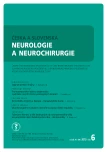Magnetic Resonance Imaging in Traumatic Brain Injury – a Case Report
Authors:
Š. Reguli 1; R. Lipina 1; J. Krajča 2; P. Hanzlíková 3
Authors‘ workplace:
Neurochirurgická klinika FN Ostrava
1; Radiodiagnostické oddělení FN Ostrava
2; Magnetická rezonance, Centrum zdraví Sagena, Frýdek-Místek
3
Published in:
Cesk Slov Neurol N 2013; 76/109(6): 736-739
Category:
Case Report
Overview
At present, the main goal of brain trauma management is to minimize the secondary injury of the brain that starts immediately after the primary insult and is often crucial for survival and patient’s quality of life. It is, therefore, no surprise that imaging methods are a subject to increasing demand on their functionality. It is essential to specify the extent, localisation (including prognosticaly important brain stem lesions) and type (important for prediction of endangered area) of a lesion as precisely and as soon as possible. A non-contrast CT scan (that still is the golden standard in the majority of institutions) does not seem to suffice anymore. Our case study presents an example where magnetic resonance imaging (MRI) was employed in a paediatric patient with traumatic brain injury and emphasizes the importance of MRI in the investigational protocol. In the discussion, we debate current practice and requirements for the use of MRI in diagnosis, prognosis and selection of optimal therapeutic strategy in patients with brain injury.
Key words:
magnetic resonance imaging – brain trauma – diffuse axonal injury
The authors declare they have no potential conflicts of interest concerning drugs, products, or services used in the study.
The Editorial Board declares that the manuscript met the ICMJE “uniform requirements” for biomedical papers.
Sources
1. Toyama Y, Kobayashi T, Nishiyama Y, Satoh K, Ohkawa M, Seki K. CT for acute stage of closed head injury. Radiat Med 2005; 23(5): 309– 316.
2. Brichtová E. Analýza souboru pacientů s kraniocerebrálním poraněním léčených na Pracovišti dětské medicíny FN Brno v období let 2000– 2007. Cesk Slov Neurol N 2008; 71/ 104(4): 466– 471.
3. Servadei F, Nasi MT, Giuliani G, Cremonini AM, Cenni P, Zappi D et al. CT prognostic factors in acute subdural haematomas: the value of the ‚worst‘ CT scan. Br J Neurosurg 2000; 14(2): 110– 116.
4. Lagares A, Ramos A, Pérez– Nuñez A, Ballenilla F, Alday R, Gómez PA et al. The role of MR imaging in assessing prognosis after severe and moderate head injury. Acta Neurochir 2009; 151(4): 341– 356.
5. Firsching R, Woischneck D, Klein S, Reissberg S, Döhring W, Peters B. Classification of severe head injury based on magnetic resonance imaging. Acta Neurochir 2001; 143(3): 263– 271.
6. Ashikaga R, Araki Y, Ishida O. MRI ofheadinjuryusing FLAIR. Neuroradiology 1997; 39(4): 239– 242.
7. Akiyama Y, Miyata K, Harada K, Minamida Y, Nonaka T, Koyanagi I et al. Susceptibility- weighted magnetic resonance imaging for the detection of cerebral microhemorrhage in patients with traumatic brain injury. Neurol Med Chir 2009; 49(3): 97– 99.
8. Tong KA, Ashwal S, Holshouser BA, Shutter LA, Herigault G, Haacke EM et al. Hemorrhagic shearing lesions in children and adolescents with posttraumatic diffuse axonal injury: improved detection and initial results. Radiology 2003; 227(2): 332– 339.
9. Albensi BC, Knoblach SM, Chew BG, O‘Reilly MP, Faden AI, Pekar JJ. Diffusion and high resolution MRI of traumatic brain injury in rats: time course and correlation with histology. Exp Neurol 2000; 162(1): 61– 72.
10. Davis SM, Donnan GA, Butcher KS, Parsons M. Selection of thrombolytic therapy beyond 3 h using magnetic resonance imaging. Curr Opin Neurol 2005; 18(1): 47– 52.
11. Latchaw RE, Yonas H, Hunter GJ, Yuh WT, Ueda T,Sorensen AG et al. Guidelines and recommendations for perfusion imaging in cerebral ischemia: a scientific statement for healthcare professionals by the writing group on perfusion imaging, from the Council on Cardiovascular Radiology of the American Heart Association. Stroke 2003; 34(4): 1084– 1104.
12. Garnett MR, Blamire AM, Corkill RG, Rajagopalan B,Young JD, Cadoux- Hudson TA et al. Abnormal cerebral blood volume in regions of contused and normal appearing brain following traumatic brain injury using perfusion magnetic resonance imaging. J Neurotrauma 2001; 18(6): 585– 593.
13. Kou Z, Wu Z, Tong KA, Holshouser B, Benson RR, Hu J et al. The role of advanced MR imaging findings as biomarkers of traumatic brain injury. J Head Trauma Rehabil 2010; 25(4): 267– 282.
14. Hutchinson PJ, Corteen E, Czosnyka M, Mendelow AD, Menon DK, Mitchell P et al. Decompressive craniectomy in traumatic brain injury: the randomized multicenter RESCUEicp study (www.RESCUEicp.com). Acta Neurochir Suppl 2006; 96: 17– 20.
Labels
Paediatric neurology Neurosurgery NeurologyArticle was published in
Czech and Slovak Neurology and Neurosurgery

2013 Issue 6
- Metamizole vs. Tramadol in Postoperative Analgesia
- Memantine in Dementia Therapy – Current Findings and Possible Future Applications
- Memantine Eases Daily Life for Patients and Caregivers
- Metamizole at a Glance and in Practice – Effective Non-Opioid Analgesic for All Ages
- Advances in the Treatment of Myasthenia Gravis on the Horizon
Most read in this issue
- Frontotemporal Lobar Degeneration from the Perspective of the New Clinical‑ Pathological Correlations
- Tuberous Sclerosis Complex in Children Followed from Neonatal Period for Prenatally Diagnosed Cardiac Rhabdomyoma – Two Case Reports
- Pineal Region Expansions
- Occipital Condyle Fractures
